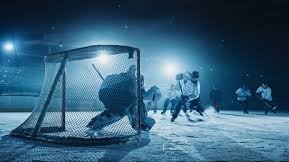Rules of the game
In hockey, there are 6 players to each side, one of which is the goalie. The goalie can be pulled for an extra player. Hockey teams usually consist of 4 lines, totally to 20 players.
Hockey is a very intense sport. Players are usually on the ice for only 1 minute at a time before being substituted on the fly. Changing the players is called a "line change" As the Puck is relatively small compared to a football and as hockey is played very fast, it's very easily to loose sight of what's going on. Which is why lights flash after a goal has been made, so that everyone knows a goal was scored. There is 60 minutes of ice time in a game, which are split into 3 periods. Between the periods, there are 15 minute breaks. The play clock stops when the puck is not on the ice. During stoppages, the players are usually substituted. Games typically take two and a half hours. Also, at the end of each period, teams switch sides. When the score is tied at the end of regulation, there is overtime. In the NHL, overtime is played in a 3 on 3 scenario, first goal wins. If after the overtime a goal has not been scored, the game moves into a shootout.
The hockey rink
The hockey rink featuring lines and dots. With that, every line has a reason. We'll explain it.
The rink is divided into three sections by two blue lines. The defensive zone is where your goal is, and the opponent's goal is in the offensive zone. The neutral zone is in the middle. By the goals, there is the red goal line. In hockey, you may play behind the goals but not in the blue half circle, called crease. The referee crease can be found in the neutral zone. On the rink, there are 8 red dots - 4 with circles. They are called face off zones . After the play is blown dead, the puck will be placed at the nearest faceoff zone. Penalties In ice hockey, there are often fights. For the layman, this is an exciting part of the game. Physical contact is an important part of the game. It is allowed, and also tactically important, to check your opponent. Fisticuffs are usually punished with a 5 minute penalty for both partys. So that things don't get out of hand, there are hard rules. We've summarised the most important penalties. The most important rule is offside. When entering the attacking zone, if you or a team member crosses the blue line before the puck, the play is whistled dead and a faceoff will occur in the neutral zone. Players are allowed to play the puck with their skates, but players cannot kick the puck into the goal. Another classic rule break applies to the hockey stick. End of the stick may never be held above the shoulders. Fouls also include tripping, cross-checking and hooking. Most penaltys are 2 minutes but can go up to 10 minutes. During this time, the team plays a man down. This period is called a power play. If the opposing team score a goal during this time, the penalised player re-enters the game.

The penalty dictates the punishment. The offender can be penalised for up to 10 minutes or even be removed from the game and suspended from following games. Ice hockey players wear helmets and pads because full body contact is allowed. The ice hockey encyclopedia Here are the most common hockey terms: Face-off: After a stop in play, the referee throws the puck into play at one of many face-off circles. The two players taking the face-off stand across from each other. Both battle for team possession of the puck. Icing: Behind each goal is a thin long blue line, and in the middle of the rink is a red line. If a player shoots the puck from behind the red line and it crosses the thin blue line in the offensive zone without touching a stick, icing is called. A face-off then occurs in the defensive zone. If a team is shorthanded, they may ice the puck without icing being called.